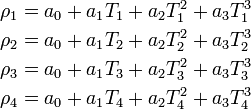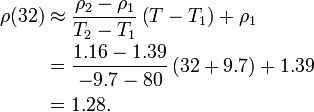Difference between revisions of "Interpolation"
m (→Implementation in Excel) |
(→Example) |
||
| Line 120: | Line 120: | ||
Using a third degree polynomial and the data in the table above, approximate the density of air at 50 °F and 300 °F. | Using a third degree polynomial and the data in the table above, approximate the density of air at 50 °F and 300 °F. | ||
| − | We require 4 points to fit a third degree polynomial, <math>a_0, \, a_1, \, a_2, \, a_3</math>. | + | We require 4 points to fit a third degree polynomial, <math>a_0, \, a_1, \, a_2, \, a_3</math>. The equations to be solved are: |
| + | <center><math>\begin{align} | ||
| + | \rho_1 &= a_0 + a_1 T_1 + a_2 T_1^2 + a_3 T_1^3 \\ | ||
| + | \rho_2 &= a_0 + a_1 T_2 + a_2 T_2^2 + a_3 T_2^3 \\ | ||
| + | \rho_3 &= a_0 + a_1 T_3 + a_2 T_3^2 + a_3 T_3^3 \\ | ||
| + | \rho_4 &= a_0 + a_1 T_4 + a_2 T_4^2 + a_3 T_4^3 | ||
| + | \end{align}</math></center> | ||
| + | Once we have solved these equations we have the polynomial coefficients and we can then evaluate the resulting polynomial at any temperature that we wish. | ||
| − | + | We still must choose what 4 points in the table to use in the above equations. We will choose the 4 points in the table that are closest to the temperature that we wish to interpolate to. Note that if we want to evaluate the density at different temperatures, we may want to use different points in the table to determine the coefficients! | |
| − | Our procedure is: | + | |
| + | Our procedure to perform the interpolation is: | ||
# Determine which points we need to use. | # Determine which points we need to use. | ||
# Set up and solve the linear system to obtain the polynomial coefficients <math>a_0 \ldots a_3</math>. | # Set up and solve the linear system to obtain the polynomial coefficients <math>a_0 \ldots a_3</math>. | ||
# Evaluate the polynomial to obtain the temperature. | # Evaluate the polynomial to obtain the temperature. | ||
| + | |||
| + | ==== Implementation in Matlab ==== | ||
The MATLAB code to obtain the density at 50 °F is | The MATLAB code to obtain the density at 50 °F is | ||
| Line 140: | Line 150: | ||
T = 50; | T = 50; | ||
| − | % determine the set of points that we will use to construct the interpolant. | + | % determine the set of points that we will use to construct |
| + | % the interpolant. We want to use points that are closest | ||
| + | % to the temperature that we are interested in. | ||
points = 1:4; | points = 1:4; | ||
| Line 155: | Line 167: | ||
</ul> | </ul> | ||
| − | For <var>T=300</var> we would repeat the above with the only change being: | + | For <var>T=300</var> we would probably want to choose a different set of points to determine the polynomial coefficients. Therefore, we would repeat the above with the only change being: |
<ul><source lang="matlab"> | <ul><source lang="matlab"> | ||
T=300; | T=300; | ||
points=4:8; | points=4:8; | ||
</source></ul> | </source></ul> | ||
| − | |||
| − | |||
== Cubic Spline Interpolation == | == Cubic Spline Interpolation == | ||
Revision as of 15:58, 1 September 2008
Contents
Linear Interpolation
A linear function may be written as
 Given any two data points,
Given any two data points,  , and
, and  , we can determine a linear function that exactly passes through these points. We can do this by solving for
, we can determine a linear function that exactly passes through these points. We can do this by solving for  and
and  . Since there are two unknowns we require two equations. They are:
. Since there are two unknowns we require two equations. They are:

These may be written in matrix form as
![\left[ \begin{array}{cc} 1 & x_1 \\ 1 & x_2 \end{array} \right]
\left( \begin{array}{c} a_0 \\ a_1 \end{array} \right)
=
\left( \begin{array}{c} y_1 \\ y_2 \end{array} \right)](/wiki/images/math/8/9/d/89d586401931241c16145d9dbb27201a.png)
Given values for  , and
, and  , these equations may be easily solved in MATLAB. But since they are so simple, we can easily by hand to obtain a general solution,
, these equations may be easily solved in MATLAB. But since they are so simple, we can easily by hand to obtain a general solution,

This gives the coefficients, which may then be substituted into the original equation  and simplified to obtain
and simplified to obtain

This is a very convenient equation for performing linear interpolation.
Example
The density of air at various temperatures and atmospheric pressure is given in the following table
| Temperature (°F) | 1.39 | 1.16 | 0.99 | 0.87 | 0.78 | 0.69 | 0.63 | 0.58 | 0.54 | 0.50 | 0.46 | 0.44 | 0.41 |
|---|---|---|---|---|---|---|---|---|---|---|---|---|---|
| Density (kg/m3) | -10 | 80 | 170 | 260 | 350 | 440 | 530 | 620 | 710 | 800 | 890 | 980 | 1070 |
Estimate the density of air at 32 °F. Using linear interpolation, we have  .
We define
.
We define  and
and  . Now we can calculate
. Now we can calculate
Implementation in Matlab
There are three ways to do interpolation in MATLAB.
- Solve the linear system.
T1=-9.7; T2=80; rho1=1.39; rho2=1.16; T = 32; A = [ 1 T1; 1 T2 ]; b = [ rho1; rho2 ]; a = A\b; rho = a(1) + a(2)*T;
- Use the general equation we derived above:
T1=-9.7; T2-80; rho1=1.39; rho2=1.16; T = 32; rho = (rho2-rho1)/(T2-T1) * (T-T1) + rho1;
- Use MATLAB's built-in interpolation tool
Ti = [-9.7 80]; rhoi = [1.39 1.16]; rho = interp1( Ti, rhoi, 32 );
All three of these methods provide exactly the same answer. However, using MATLAB's interp1 function allows you to use a vector for the points that you want to interpolate to. For example, if we wanted the density at 30, 50, 70, 10, and 110 °F, we could accomplish this by:
Ti = [-9.7 80 170 ];
rhoi = [1.39 1.16 0.995];
T = 30:20:110;
rho = interp1( Ti, rhoi, T );
Implementation in Excel
|
Polynomial Interpolation
Polynomial interpolation is a simple extension of linear interpolation. In general, an nth degree polynomial is given as
If n=1 then we recover a first-degree polynomial, which is linear. The formula gives  .
.
In general, if we want to interpolate a set of data using an nth degree polynomial, then we must determine n+1 coefficients,  . Therefore, we require n+1 points to interpolate using an nth degree polynomial.
. Therefore, we require n+1 points to interpolate using an nth degree polynomial.
The equations that must be solved are given as
![\left[\begin{array}{ccccc}
1 & x_{1} & x_{1}^2 & \cdots & x_{1}^{n}\\
1 & x_{2} & x_{2}^2 & \cdots & x_{2}^{n}\\
\vdots & \vdots & \vdots & \cdots & \vdots \\
1 & x_{n+1} & x_{n+1}^2 & \cdots & x_{n+1}^{n}\end{array}\right]\left(\begin{array}{c}
a_{0}\\
a_{1}\\
\vdots\\
a_{n}\end{array}\right)
=
\left(\begin{array}{c}
y_{1}\\
y_{2}\\
\vdots\\
y_{n+1}\end{array}\right)](/wiki/images/math/5/d/e/5dec415feed2a5970262778546fd8a82.png)
Solving these equations provides the values for the coefficients,  . Once we know these coefficients, we can evaluate the polynomial at any point.
. Once we know these coefficients, we can evaluate the polynomial at any point.
Example
Using a third degree polynomial and the data in the table above, approximate the density of air at 50 °F and 300 °F.
We require 4 points to fit a third degree polynomial,  . The equations to be solved are:
. The equations to be solved are:

Once we have solved these equations we have the polynomial coefficients and we can then evaluate the resulting polynomial at any temperature that we wish.
We still must choose what 4 points in the table to use in the above equations. We will choose the 4 points in the table that are closest to the temperature that we wish to interpolate to. Note that if we want to evaluate the density at different temperatures, we may want to use different points in the table to determine the coefficients!
Our procedure to perform the interpolation is:
- Determine which points we need to use.
- Set up and solve the linear system to obtain the polynomial coefficients
 .
. - Evaluate the polynomial to obtain the temperature.
Implementation in Matlab
The MATLAB code to obtain the density at 50 °F is
% Set the data points from the table.
Ti = [ -9.7 80 170 260 350 440 530 ...
620 710 800 890 980 1070 ]';
rhoi=[ 1.39 1.16 0.99 0.87 0.78 0.69 0.63 ...
0.58 0.54 0.50 0.46 0.44 0.41 ]';
% Set the temperature we want to evaluate the density at.
T = 50;
% determine the set of points that we will use to construct
% the interpolant. We want to use points that are closest
% to the temperature that we are interested in.
points = 1:4;
% set up the linear system
A = [ ones(4,1), ones(4,1).*Ti(points), ones(4,1)*Ti(points).^2, ones(4,1)*Ti(points).^3 ];
b = rhoi(points);
% solve for the polynomial coefficients
a = A\b;
% evaluate the density.
rho = a(0) + a(1)*T + a(2)*T^2 + a(3)*T^3;
For T=300 we would probably want to choose a different set of points to determine the polynomial coefficients. Therefore, we would repeat the above with the only change being:
T=300;
points=4:8;
Cubic Spline Interpolation
|
Example
Implementation in Matlab
Lagrange Polynomial Interpolation
|
Given  points
points  the
the  order Lagrange polynomial that interpolates these function values,
order Lagrange polynomial that interpolates these function values,  are expressed as
are expressed as

where  is the Lagrange polynomial given by
is the Lagrange polynomial given by

and  . In other words, for an
. In other words, for an  order interpolation, we require
order interpolation, we require  points.
points.
The  operator represents the continued product, and is analogous to the
operator represents the continued product, and is analogous to the  operator for summations. For example,
operator for summations. For example,  .
.
